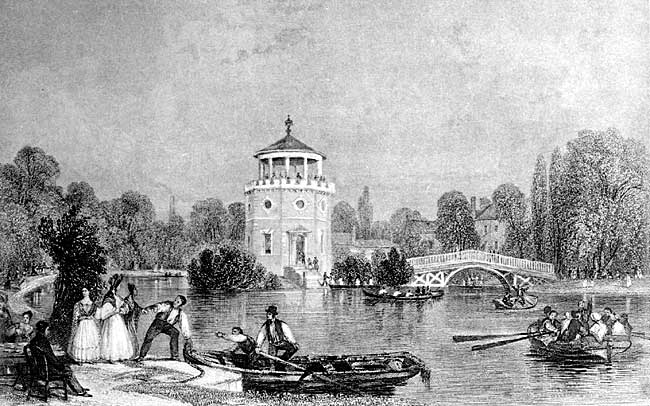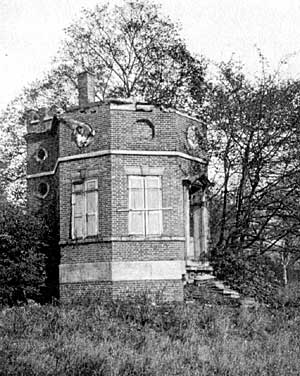Radford Grove or Folly
BY MR. R. C. SUTTON.

Radford Folly (from an old engraving).
HERE is a tombstone surrounded by a high iron railing in Old Radford churchyard with the inscription:—
WILLIAM
ELLIOTT,
Died 23 September, 1792,
Aged lxxxviii.
This gentleman bought a considerable area of land situated on the west side below the river Leen. He had a large portion excavated and filled with water forming a small lake. The water was supplied from the river Leen which was banked up and the supply regulated by a sluice at the inlet. He planted some large trees and laid out the grounds with considerable taste, placing rustic arbours in various positions. He built a good house at the entrance, near the bridge which he put over the Leen, and an ornamental building of considerable size on the island formed in the centre of the lake. This was approached by a wooden bridge with a single span arch and ornamental wooden abutments on either side, surmounted by a simple but effective railing of square uprights and ornamental capping and three large newel posts at intervals. The whole of the bridge, railing, and abutments were painted white, and in its way the bridge was a very pretty and effective item in the landscape. The large amount of money spent, and the labour entailed in forming the lake and planting the grounds in addition to the buildings, caused people to dub it “Elliott’s F’oily,” and as such it was known for a long time. Mr. Charles Sutton bought the place and let it, and eventually it became a tea garden under the name of Radford Grove. For some years it was rented by a man named Parr, and was a regular pleasure resort of Nottingham people. There were boats on the lake let at one shilling per hour, and a skittle ground was laid out.

Radford Folly at the present day.
In the summer time there was dancing on the various greens, swings and amusements for the children as well as for the older folk, and teas were served in the “round house,” an octagonal building with pagoda-like roof supported on columns. In the winter time the lake was frequented by skaters, and formed a very fine piece of ice for ornamental skating. Its fortunes varied, and after some years it failed to retain its hold on the public as a pleasure resort. Then Mr. R. Sutton had extensive alterations made and went to reside there, and again it became a private residence. He lived there with his family, and it became a pretty well-kept-up country residence, for at this time, with the exception of some old houses at the north side of the property, and Harrison’s mill at the south end abutting on the Leen, with a few tenements in the main road, there were no houses between it and Nottingham. The most direct way to Nottingham was by a footpath through a large field belonging to the Reppen family and through two other fields which brought you out on to Denman Street at Bloomsgrove and then on up Denman Street to the top of Derby Road. After the death of Mr. Sutton the property was sold to Mr. Harrison, who filled up the lake. Eventually the property came into the possession of the Colliery Company, who erected a large chimney and used it for purely utilitarian purposes, so that no one who knew it at its best can have the faintest idea of the transformation which has taken place. “Sic transit gloria mundi!”
It was considered of sufficient importance to be included in Fisher’s views of the beauty spots of the Midland Counties. The lake was well stocked with roach and perch. The writer of this paper saw a small pike caught near here in the early fifties in the Leen, then a fairly clear river.
At one side of the lake an elaborate scenic representation in boards, painted in high colours, was erected at considerable cost, with lighthouse, forts, and many buildings intended to represent Naples. For a considerable time these were illuminated with hundreds of coloured lamps, and rather good firework exhibitions were given. Mary Howitt, in her book, “Little coin, much care,” gives a description of Radford Folly as a tea garden, and mentions the fireworks display.
No idea can now be formed of this once pretty little place, all its attractive features having had to give way to the utilitarian spirit of the age.
